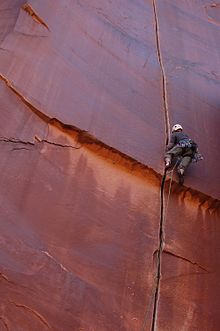
Back Rotsklim Afrikaans تسلق الصخور Arabic Скалалажанне Byelorussian Скално катерене Bulgarian Banaikan tawing BJN রক ক্লাইম্বিং Bengali/Bangla Escalada de roques Catalan Horolezectví Czech Felsklettern German Αναρρίχηση σε βράχο Greek

| Part of a series on |
| Climbing |
|---|
| Lists |
| Types of rock climbing |
| Types of mountaineering |
| Other types |
| Key actions |
| Key terms |
Rock climbing is a climbing discipline that involves ascending routes consisting of natural rock in the outdoor environment and on artificial resin climbing walls in a mostly indoor environment. Routes are chronicled in guidebooks, and on online databases, with the details of how to climb the route (called the beta), and who made the first ascent (FA) and the coveted first free ascent (FFA). Climbers will ideally try to ascend a route onsight, however, a climber can spend years projecting a route before they make a redpoint ascent.
Rock climbing routes range from a few metres to over a 1,000 metres (3,300 ft) in height, and horizontal traverses can reach 4,500 metres (14,800 ft) in length. Popular rock types include granite (e.g. El Capitan), limestone (e.g. Verdon Gorge), and sandstone (e.g. Saxon Switzerland), however, over 43 types of climbable rock types have been identified. Artificial indoor climbing walls have become very popular and competition climbing — which takes place exclusively on artificial walls — became an Olympic sport in 2020.
Contemporary rock climbing is focused on free climbing where — unlike with aid climbing — no mechanical aids can be used to assist with upward momentum. Free-climbing includes bouldering on short 5 metres (16 ft) routes, single-pitch climbing on up to 60–70 metres (200–230 ft) routes, and multi-pitch climbing — and big wall climbing in particular — on routes of up to 1,000 metres (3,300 ft). Free-climbing can be done as free solo climbing with no climbing protection whatsoever, or as lead climbing that uses either removable temporary protection (called traditional climbing), or permanently fixed bolted protection (called sport climbing).
The evolution in technical milestones in rock climbing is tied to the development in rock-climbing equipment (e.g. rubber shoes, spring-loaded camming devices, and campus boards) and of rock-climbing techniques (e.g. jamming, crimping, and smearing). The most dominant grading systems worldwide are the French numerical and the American YDS systems for lead climbing and the V-grade and the Font-grade for bouldering. As of October 2024, the hardest free climbing grade is at 9c (5.15d) and the hardest bouldering grade is at V17 (9A).
The main types of rock climbing can trace their origins to late 19th-century Europe, with bouldering in Fontainebleau, big wall climbing in the Dolomites, and single-pitch climbing in both the Lake District and in Saxony. Climbing ethics initially focused on "fair means" and the transition from aid climbing to free climbing and latterly to clean climbing; the use of bolted protection on outdoor routes remains a source of ongoing debate in climbing. The sport's profile was increased when lead climbing, bouldering, and speed climbing became medal events in the Summer Olympics, and with the popularity of films such as Free Solo and The Dawn Wall.